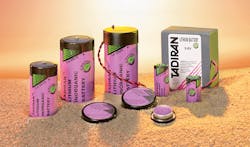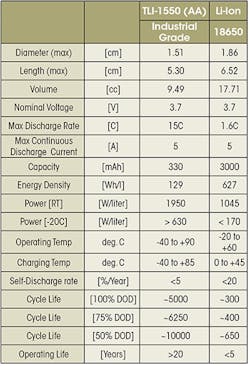Can You Have Wireless Power for the Life of a Device?
Wireless connectivity is becoming essential to the growth of artificial intelligence (AI), machine-to-machine (M2M) interoperability, and networked manufacturing solutions that span the fast-growing Industrial Internet of Things (IIoT).
To get wireless connectivity, batteries are becoming essential to enabling big data and AI to expand from the factory floor into virtually all external environments. Batteries circumvent having to hard-wire devices, which is estimated to cost $100 or more per foot. This cost ratio can skyrocket in highly remote and environmentally sensitive locations, where practicality, regulatory delays and uncertainty often demand wireless connectivity.
Pulse Plus Batteries offer high capacity and high energy density without experiencing voltage drop or power delay, which is ideal for standby applications and devices.
To go wireless, the preferred solution is to use a battery that can last for the entire life of the device, thereby reducing long-term maintenance expenses and reducing the total cost of ownership. Gas and water utility companies almost exclusively use long-life bobbin-type lithium thionyl chloride (LiSOCl2) batteries to power their AMR/AMI meter reading devices. For a manager, the thought of having to change out thousands of batteries every few years can be potentially chaotic, as it could overwhelm field-service crews. Large-scale battery failures can also compromise normal billing procedures and customer service functions such as disabling remote shut-off capabilities.
Bobbin-type LiSOCl2 batteries are primarily chosen for wireless devices deployed in highly remote locations due to their ability to operate up to 40 years. Some common examples include seismographic measuring devices placed at the bottom of the ocean floor, sensors that monitor structural stress to bridge trusses, and GPS tracking devices that monitor the size and location of icebergs floating in Arctic waters. Challenging applications such as these demand long-life batteries. However, if the device is easily accessible and operates within a moderate temperature range, then a less expensive consumer-grade primary or rechargeable battery could suffice. Every application is unique, so design engineers need to consider the full range of performance requirements and the operating environment to determine the ideal power source.
Primary lithium batteries predominantly power remote wireless devices that require long operating life.
If consumer-grade Li-ion batteries are being considered, the design engineer needs to be mindful of their limitations, including a maximum operation life of five years and 500 recharge cycles, as well as an inability to deliver the high pulses required for two-way wireless communications.
For industrial-grade energy harvesting applications that demand a more reliable long-life power source, a new generation of industrial-grade rechargeable Li-ion batteries has been developed that can deliver 20-year operating life and 5,000 full recharge cycles, along with the ability to deliver up to 15A pulses to power two-way wireless communications.
The table provides a comparison between typical lithium-ion batteries and industrial grade lithium-ion batteries.
Intelligent Product Design
In order to ensure that the battery can last as long as the device, it is essential that the equipment be designed to extend battery life by minimizing power consumption, which can be achieved several ways. First, you will require a low-power wireless communications protocol such as ZigBee, WirelessHart, or LoRA, to name a few.
Second, the embedded components and circuit architecture need to be designed so as to help minimize power consumption.
Third, the device should remain in a “standby” state that draws little or no energy. The device will only awaken to query or transmit data either periodically or if pre-established data limit thresholds have been exceeded. After performing its task, the device should power down rapidly to further conserve energy.
About the Author
Sol Jacobs
VP & General Manager
Sol Jacobs, VP and General Manager for Tadiran Batteries, has over 30 years of experience in powering remote devices. His educational background includes a BS in Engineering and an MBA.




